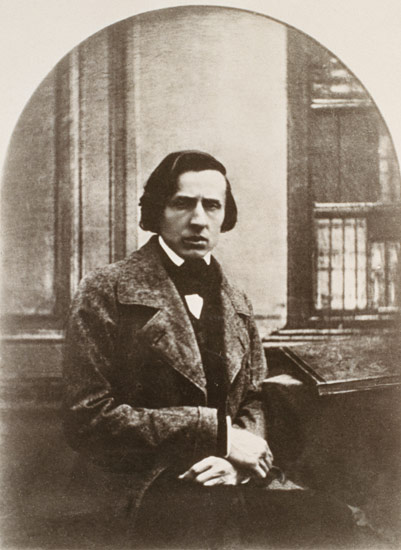7.3: 19th-Century Piano Composers
- Page ID
- 165651
The Piano in the 19th Century: Frederic Chopin
By the 19th century, the piano became a common fixture in middle class homes. It was essentially the television of the middle class. Instruments were much cheaper to produce because of the advances in manufacturing during the Industrial Revolution, and many people used the piano for at-home entertainment. It was common for children and adults alike to learn how to read music and play at the piano. Some composers like Hungarian composer Franz Liszt arranged orchestral music for piano so that those who could not attend orchestra performances to hear famous works could at least perform piano arrangements of them.
 In the 19th century, composers wrote an incredible amount of music for solo piano, chamber groups with piano, and songs for voice and piano. We also see the rise of the piano composer in this era. Composers like Frederic Chopin (1810-49) earned his living by composing, performing, and teaching piano -- he wrote over 230 works for solo piano, and only a handful of pieces for other instruments. Everything that he wrote included the piano in some way. Many of the pieces that he wrote were single movements, each of which had their own unique form and style.
In the 19th century, composers wrote an incredible amount of music for solo piano, chamber groups with piano, and songs for voice and piano. We also see the rise of the piano composer in this era. Composers like Frederic Chopin (1810-49) earned his living by composing, performing, and teaching piano -- he wrote over 230 works for solo piano, and only a handful of pieces for other instruments. Everything that he wrote included the piano in some way. Many of the pieces that he wrote were single movements, each of which had their own unique form and style.
Chopin was born in Poland, though moved to Paris when he was 21, never to return due to political strife involving Poland and Russia. His love of Poland never died, however. He, along with many other composers of the 19th century, were ardent nationalists: Nationalism in the 19th century was a political and cultural movement that sought to break away from the larger empires in favor of self-autonomy. Artists and composers from different countries in Europe had sought to establish their own musical and artistic style that separated them from other countries. Composers of French, Italian, Russian, Slovakian, Hungarian, Spanish and other countries all sought to establish their own musical style.
As a Polish nationalist at heart, Chopin wrote piano music based off of Polish dances, including mazurkas and Polonaises. Watch this video of Marjan Kiepura perform an exciting Mazurka in B flat major. You may notice that as the performer plays, it's a bit difficult to keep a beat. You might ask "how can I dance to this, if he keeps slowing down and speeding up?" This is because the performer is playing with rubato, which is term that refers to the slowing and speeding of the tempo. The term literally translates to "robbed time," which is part of the interesting character of the music. Other mazurkas are a bit more somber like this one in A minor.
Chopin was also a Romantic in style. As mentioned earlier, the Romantic era was a movement in the 19th century where composers really sought to be emotionally expressive with their music. One of the ways they could do this was by creating incredibly lyrical melodies in their instrumental music --- the idea was to "make the instrument sing." This is perfectly embodied in Chopin's Nocturnes -- short pieces that evoke a calming atmosphere. These two nocturnes are contrasting in character: one is bit more somber and dark, while the second is a little more on the bright side. Both of them, however, have incredibly lyrical melodies, which are perfect examples of the Romantic style.
Chopin also wrote Etudes, which are short concert pieces that test the limits of the performer. The word "etude" translates to "study," or a "piece that students study to get better." Chopin, being a professional pianist, took the etude and turned it into a concert piece that only professionals could even attempt to perform. True to its name, each etude focuses on a single aspect of the pianists' abilities. Watch this video of Evengy Kissin playing Chopins' "Wave" Etude, which focuses on the pianists' ability to move up and down the keyboard with both hands simultaneously.
Chopin wrote other works as well: walzes, preludes, concertos, songs for soprano and piano, piano sonatas---you name it, he wrote it! But these pieces listed above give a good taste of what type of music Chopin was writing during the 19th century.
When you watch the video presentation on this unit, you'll also come across another etude by a 20th century composer named Gyorgi Ligeti. Again, it challenges the performer's abilities, but like much music of the 20th century, it's incredibly dissonant and chaotic.
(above): photograph of Chopin, by Louis-Auguste. Public Domain.

